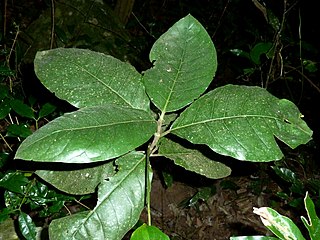
The Rubiaceae are a family of flowering plants, commonly known as the coffee, madder, or bedstraw family. It consists of terrestrial trees, shrubs, lianas, or herbs that are recognizable by simple, opposite leaves with interpetiolar stipules and sympetalous actinomorphic flowers. The family contains about 13,500 species in about 620 genera, which makes it the fourth-largest angiosperm family. Rubiaceae has a cosmopolitan distribution; however, the largest species diversity is concentrated in the tropics and subtropics. Economically important genera include Coffea, the source of coffee, Cinchona, the source of the antimalarial alkaloid quinine, some dye plants, and ornamental cultivars.
Multidentia is a genus of flowering plants in the family Rubiaceae.
Robynsia is a monotypic genus of flowering plants in the family Rubiaceae. It was described by John Hutchinson and was named after his friend and colleague Walter Robyns. The genus contains only one species, Robynsia glabrata, which is found in Ghana, Ivory Coast and Nigeria. The species is morphologically similar to the genus Cuviera but differs by having long, slender corolla tubes.

Rothmannia is a genus of flowering plants in the family Rubiaceae. It was described in 1776 and is named for Göran Rothman (1739–1778) by Thunberg – both were pupils of Linnaeus.
Rytigynia is a genus of flowering plants in the family Rubiaceae. It is found in tropical and southern Africa. The genera Rytigynia and Fadogia form a strongly supported clade but neither of these genera is monophyletic.

Vangueria is a genus of flowering plants in the family Rubiaceae. The genus is named for Voa vanguer, as V. madagascariensis is known in Malagasy.
Vangueriopsis is a genus of flowering plants in the family Rubiaceae.

Vanguerieae is a tribe of flowering plants in the family Rubiaceae and contains about 655 species in 30 genera. It is one of the most species-rich groups within the family and it is distributed all over the Paleotropics.

Fadogia is a genus of flowering plants in the family Rubiaceae. The genera Rytigynia and Fadogia form a strongly supported clade but neither of these genera is monophyletic.
Vangueriopsis rubiginosa is a species of flowering plants in the family Rubiaceae.
Hutchinsonia is a genus of flowering plants in the family Rubiaceae. It was described by Walter Robyns in 1928 and was named after his friend and colleague John Hutchinson. It is found in west tropical Africa.
Eriosemopsis is a monotypic genus of flowering plants in the family Rubiaceae. It was described by Walter Robyns in 1928 and no changes have been made since then. The genus contains only one species, viz. Eriosemopsis subanisophylla, which is endemic to KwaZulu-Natal, South Africa. The species is morphologically similar to the species Pygmaeothamnus zeyheri but differs by having a thick indumentum, raised venation and elliptical leaves.

Plectroniella is a monotypic genus of flowering plants in the family Rubiaceae. It was described by Walter Robyns in 1928. The genus contains only one species, i.e. Plectroniella armata, which is found in southern Mozambique and northeastern South Africa. The species is characterized by the presence of large spines and is morphologically similar to Canthium. In 2004, a molecular phylogenetic study showed that Plectroniella armata is related to Canthium ciliatum and the transfer of the genus to Canthium was suggested.

Meyna is a genus of flowering plants in the family Rubiaceae.
Pygmaeothamnus is a monotypic genus of flowering plants in the family Rubiaceae. It was described by Walter Robyns in 1928 and originally held four species. It is found in central and southern Africa.
Fadogiella is a small genus of flowering plants in the family Rubiaceae. It was described by Walter Robyns in 1928.
Vangueriella is a genus of flowering plants in the family Rubiaceae. The genus is found in tropical Africa.

Hakea dohertyi, commonly known as the Kowmung hakea, is a shrub endemic to a restricted locale in the Great Dividing Range in central New South Wales in Australia.

Vangueria bowkeri is a species of flowering plant in the family Rubiaceae. It is endemic to South Africa and Eswatini. It was described by Walter Robyns in 1928 and named after Colonel James Henry Bowker, the collector of the type specimen.
Vangueria cinerascens is a species of flowering plant in the family Rubiaceae. It is found from Tanzania to South Tropical Africa. The epithet is a Latin adjective meaning ash-coloured, referring to the indumentum on the leaves.








